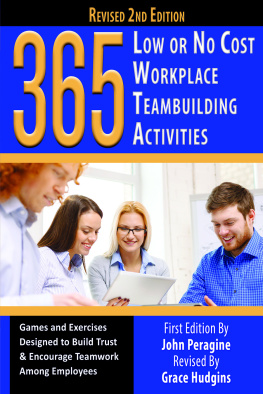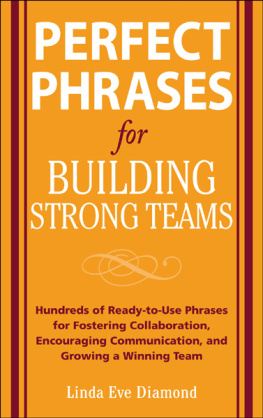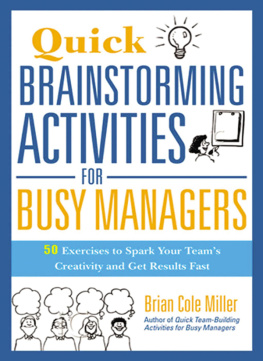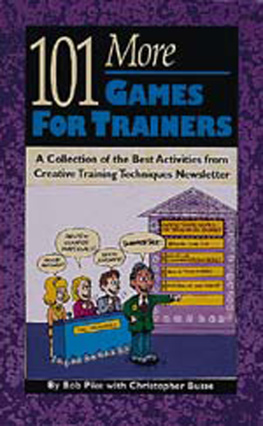
Contents
Activities to break the ice or warm the relationship with your employees
Employees describe great moments in their personal or professional lives.
Manager and employee have a spontaneous conversation by beginning each statement with a particular letter of the alphabet.
Participants use a range of emotions as prompts to share information.
Participants have fun guessing which claims made by their peers are true and which are not.
Employees share information about what they have taught themselves in the past and what they plan to teach themselves in the future.
Activities to create a positive work environment
Employees explore the idea that sometimes its OK to settle for good enough rather than to hold out for perfection.
Employees write their job descriptions in the style of a retail catalog.
During a meeting, some participants secretly play roles that help to make the meeting a positive experience for all.
Two effective visualization exercises encourage employees to maintain a positive self-image and to energetically work toward their goals.
Employees use a list of powerful verbs to stimulate ideas about how their work makes a difference in peoples lives.
Activities to foster collaboration and support
Employees establish some guidelines for a positive and productive work environment.
Employees secretly observe one another, focusing on positive aspects of their secret buddys character and work.
Employees capture the positive emotions and strong sense of accomplishment that they feel after working hard toward a goal.
Employees each present a project theyre currently working on and describe its value to the team, to the organization, and/or to customers.
Employees work in two groups to complete a puzzle, and each group has to work under different constraints.
Activities to encourage higher productivity
Employees come up with various ways to increase productivity by implementing a daily change.
Employees work toward a goal and, once theyve reached it, have a chance to try for a prize.
Employees enjoy a catch-up period in which they are able to turn away any new work.
Employees complete a questionnaire that managers can use to gain insights about how to reward employees for their success.
Employees take an honest look at how theyre really spending their time and energy at work, and then look at how they can be more productive and less stressed.
Activities to help you delegate responsibilities and empower employees
This activity helps you to empower employees and transform them from problem reporters into problem solvers.
In this relay-style activity, employees each find a piece of information and then share the information, ultimately realizing that the sum is greater than the parts.
Employees work together to determine what should and should not be done in the department and/or organization.
Employees follow the lead of the Declaration of Independence by establishing that certain truths are self-evident and in the process empower and motivate themselves to go forward.
Employees brainstorm creative ideas for serving their internal and external customers.
Through simulating the completion of some grand-scale projects, employees discover that every projectno matter how largebecomes manageable once it is broken down into smaller tasks.
Activities to tap your employees creativity and innovation
In this inspiring, thought-provoking activity, employees come up with ideas for their own fictional charity or nonprofit organization.
Employees work in small groups to come up with job aids that will help the department or organization to work more efficiently.
Employees practice their presentation and persuasion skills by competing with one another to win over buyers.
Employees work together to create a mock-up newspaper that covers various aspects of the organizationin the future.
Using a variety of common game items, employees work in small groups to invent entirely new games for their peers to play.
Activities to gain insights on leadership from your employees
Participants come up with haiku poems to simply and concisely illustrate their perspectives on leadership.
Employees brainstorm leadership qualities and then reveal which ones are most important to them.
Employees read partial quotes by famous leaders and try to come up with the missing words.
Employees recall a favorite leader from their pastteacher, coach, mentor, or managerand describe why that person left such a lasting and favorable impression on the employee.
Activities to improve your teams verbal and nonverbal communication
Through some fun experiential learning, employees determine key aspects of communication in the face-to-face, phone, and e-mail environments.
Employees practice some key skills for communication with coworkers when they are requesting help or information.
Employees act out various emotions without using any words, as the rest of the group guesses what is being communicated.
Employees revise a series of negative statements in order to make them more positive and upbeat.
Employees look at several pictures of individuals and then discuss what impressions they get in just five seconds.
Activities to alleviate stress and increase fun in the workplace
In this quick, energizing activity, employees focus on one thing they have to look forward to before the end of the day.
Working in small groups, employees use the letters of their names to come up with a range of words and phrases.
Employees have fun coming up with fictional job titles for themselves, using a variety of quirky and impressive words.
Employees share humorous anecdotes in a unique and surprising way.
Employees quickly rotate to various stations where they offer serious and not-so-serious ideas for one another.
Solo activities for the leader to do
This two-part exercise helps managers translate intentions into actions. Its an effective on-your-own activity that uncovers important aspects of ones management style.
This activity encourages the leader to regularly praise his or her employees and offers tips and techniques for making this a valuable, mutually rewarding experience.
The manager tests his or her own familiarity with the work environment and with the individualities of employees.
Leaders write their own (fictional) retirement party tribute, highlighting key aspects of their career and leadership style.
In this simple, illuminating exercise, leaders come up with two lists that help to guide their actions and philosophy as leaders.

Copyright 2004 by Vasudha K. Deming. All rights reserved. Except as permitted under the United States Copyright Act of 1976, no part of this publication may be reproduced or distributed in any form or by any means, or stored in a database or retrieval system, without the prior written permission of the publisher.
Next page







